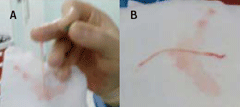The transradial approach is increasingly used in a wide range of percutaneous coronary interventions (PCIs) with few reported complications. It is established as a safe procedure with improved patient comfort and early mobilisation.1-3 This has translated into early discharge with reduced procedural cost leading to out-patient day-case PCI.4,5 However, with this increasing use, unusual and new complications will be recognised.
Case report

A 62-year-old woman was admitted with troponin positive acute coronary syndrome and was transferred to our centre for intervention. She underwent PCI via the right radial artery (RA). The RA was easily cannulated and a guide-wire passed. Due to resistance, a short non-hydrophilic introducer sheath could not be advanced and was changed to a long hydrophilic-coated sheath, which was introduced without difficulty. Aspirating the sheath showed an elongated cylindrical piece of tissue (figures 1); this was subsequently confirmed, on histopathology, as arterial endothelium.
The procedure was completed successfully with stenting of the left anterior descending artery. Attempts to remove the sheath at the end of the procedure proved difficult due to severe RA spasm despite intravenous sedation and intra-arterial vasodilators. General anaesthetic was required at the end to facilitate the removal of the sheath. There was no evidence of any adverse effect with preserved RA pulse and normal function and sensation of the hand.
Discussion
With the increasing use of the RA approach, unusual complications will be recognised and it is important to report them and raise the awareness of their occurrence. To our knowledge, this complication and stripping of the RA endothelium has not been reported previously.
The use of the non-hydrophilic short sheath may be more prone to causing RA spasm, and may, in this case, have stripped the endothelium, which was subsequently removed by the hydrophilic sheath. Similarly, this case also highlights the importance of aspiration after sheath insertion, as the tissue may have been pushed upstream and led to serious complications.
The use of the RA approach will continue to expand and more unusual complications may be encountered. It is important to continue to report them and make medical practitioners aware of their occurrence.
Conflict of interest
None declared.
References
- Eccleshall SC, Banks M, Carroll R, Jaumdally R, Fraser D, Nolan J. Implementation of diagnostic and interventional transradial programme: resource and organisational implications. Heart 2003;89:561–2.
- Kiemeneij F, Laarman GJ, Odekerken D et al. A randomised comparison of percutaneous transluminal coronary angioplasty by the radial, brachial and femoral approaches: the access study. J Am Coll Cardiol1997;29:1269–75.
- Eccleshall S, Muthusamy T, Nolan J. The transradial access site for cardiac procedures: a clinical perspective. Stent 1999;2(3):74–9.
- Gioia G, Comit C, Moreyra AE. Coronary rotational atherectomy via transradial approach: a study using radial artery intravascular ultrasound. Catheter Cardiovasc Interv 2000;51:234–8.
- Kiemeneij F, Hofland J, Laarman GJ, van der Elst DH, van der Lubbe H. Cost comparison between two modes of Palmaz Schatz coronary stent implantation: transradial bare stent technique vs transfemoral sheath-protected stent technique. Cathet Cardiovasc Diagn 1995;35:301–08.
